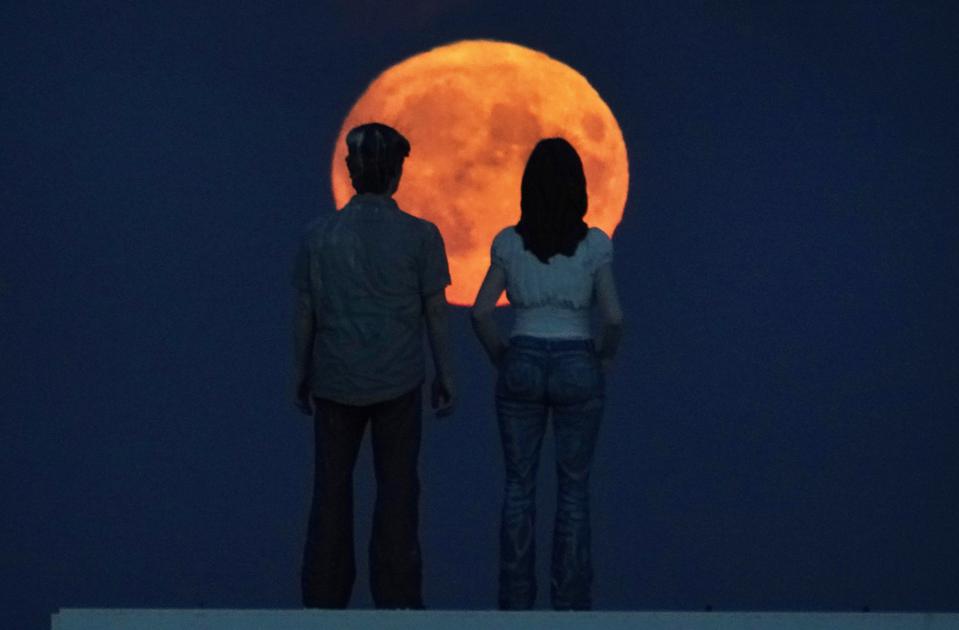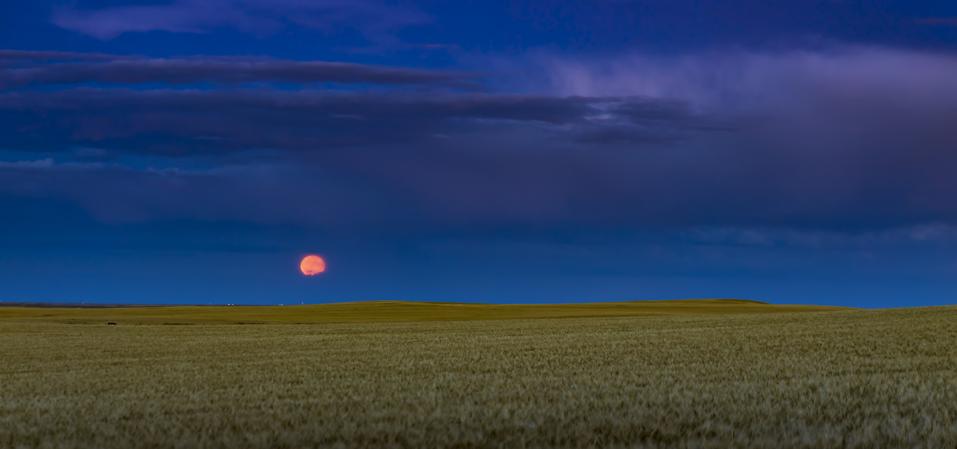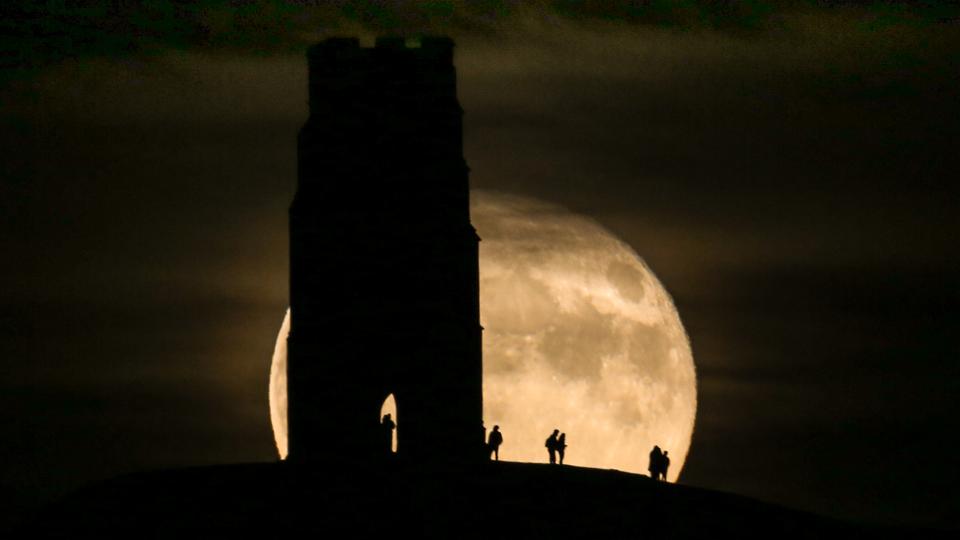Science
Your ‘Harvest Moon’ Moment Is An Illusion: Why This Week’s Full Moon Will Look Big But Be Small – Forbes

A ‘Harvest Moon’ rising. Why does it look so big?
PA Images via Getty Images
Look low on the eastern horizon close to dusk this Thursday, October 1, 2020, and you’ll see—clear skies allowing—a massive “Harvest Moon” rising.
The first of a few famous full Moons this coming season, the Harvest Moon is so-called because it helps farmers get the crop in late into the night. Of course, that’s not how modern farmers work, but as with all full Moons it will rise in the east, opposite the sunset, shine all night long, and set in the west, opposite a sunrise.
As its rises and sets the Harvest Moon will also look huge. All full Moons do.
However, this Harvest Moon is different.
Although it’s in its “full” phase this week, the Harvest Moon will be relatively small because come Saturday the Moon will be at apogee, the furthest point along its slightly elliptical 27.5 day orbit of Earth.
It will be 406,000 km from us and be smaller and less bright than usual.
So why will this small full Moon look so big but be so small?


Last year’s ‘Harvest Moon’ was the apogee (smallest) full Moon of 2019. (Photo by: Alan … [+]
VWPics/Universal Images Group via Getty Images
Why will the ‘Harvest Moon’ look so big?
“The Moon will appear massive in the sky for the simple reason that you’ve got a little bit of magnification with the atmosphere,” said Martin Griffiths, a Wales-based science communicator, professional astronomer at Dark Sky Wales and author of Dark Land, Dark Skies: The Mabinogion in the Night Sky. “You’ve also got features in the landscape, which of course are knowable as far as a height is concerned.”
Whether you watch a full Moon rise behind a tree, between buildings or above the roofs of houses, our brains make comparisons between them and the size of the Moon.
It’s an optical illusion that lasts only a few minutes.
As soon as the full Moon has risen above the horizon, that context and those comparisons are lost. The full Moon appears to shrink.
However, not only is it an illusion, but in fact, the opposite is true—the Moon is actually at its smallest as it rises.
Why will the ‘Harvest Moon’ be so small?
“Though it doesn’t appear that way, when you’re looking at the Moon when it’s rising it’s actually at its smallest,” said Griffiths. “That’s because you’ve got the entire radius of the Earth between you and the rising Moon.”
Conversely, when the Moon is high above your head at midnight—when it appears to be at its smallest because there’s nothing for our brains to compare it to—it’s technically at its biggest. “You haven’t got that radius anymore, you’ve got just the distance between you and the Moon, so it’s actually closer then,” said Griffiths. “The problem is, you’ve got nothing to compare it to, so it looks wrong.”
How big is the ‘Harvest Moon?’
All full Moons are tiny.
The apparent diameter of the Moon is only 0.5º. The celestial sphere around our planet is 360º, and from any one place on Earth you can see 180º—the visible night sky (the rest is below the horizon). So 0.5º isn’t much. It’s actually just one 72,000th, the size of the sky.
“It only looks big it’s either dazzlingly bright, or it’s seen against features of the landscape, but you can always cover the Moon with the nail on your little finger held out at arm’s length,” said Griffiths.
Give it a try. It doesn’t matter how long your arm is, or how big or small you are, because all humans are built to scale.


A full Moon rising behind Glastonbury Tor, Somerset, England.
Getty Images
Where to look for the ‘Harvest Moon’ rising and setting
I’ve just posted an exhaustive guide here for watching the Harvest Moon, but the basics are that a full Moon close to the equinox—which this one is very close to—will rise almost due east and set almost due west.
The Harvest Moon is in the constellation of Pisces, and if you look to its left you’ll see rosy red Mars.
All you need is a nice, clear eastern horizon and one of nature’s most beautiful illusions is all yours. Then prepare for a “Halloween Hunter’s Blue Moon” on October 30.
Wishing you clear skies and wide eyes.
Science
NASA hears from Voyager 1, the most distant spacecraft from Earth, after months of quiet
|
|
CAPE CANAVERAL, Fla. (AP) – NASA has finally heard back from Voyager 1 again in a way that makes sense.
The most distant spacecraft from Earth stopped sending back understandable data last November. Flight controllers traced the blank communication to a bad computer chip and rearranged the spacecraft’s coding to work around the trouble.
NASA’s Jet Propulsion Laboratory in Southern California declared success after receiving good engineering updates late last week. The team is still working to restore transmission of the science data.
It takes 22 1/2 hours to send a signal to Voyager 1, more than 15 billion miles (24 billion kilometers) away in interstellar space. The signal travel time is double that for a round trip.
Contact was never lost, rather it was like making a phone call where you can’t hear the person on the other end, a JPL spokeswoman said Tuesday.
Launched in 1977 to study Jupiter and Saturn, Voyager 1 has been exploring interstellar space – the space between star systems – since 2012. Its twin, Voyager 2, is 12.6 billion miles (20 billion kilometers) away and still working fine.





Science
SpaceX launches 23 Starlink satellites from Florida (photos)


|
|
SpaceX sent yet another batch of its Starlink internet satellites skyward today (April 23).
A Falcon 9 rocket topped with 23 Starlink spacecraft lifted off from Florida’s Cape Canaveral Space Force Station today at 6:17 p.m. EDT (2217 GMT).
The Falcon 9’s first stage came back to Earth for a vertical landing about 8.5 minutes after launch as planned. It touched down on the SpaceX droneship Just Read the Instructions, which was stationed in the Atlantic Ocean.
It was the ninth launch and landing for this particular booster, according to a SpaceX mission description. Five of its previous eight liftoffs were Starlink missions.
The Falcon 9’s upper stage will continue carrying the 23 Starlink satellites toward low Earth orbit (LEO) today, deploying them about 65 minutes after liftoff.
This evening’s launch was the 41st of the year for SpaceX, and the 28th of 2024 dedicated to building out the huge and ever-growing Starlink megaconstellation. There are nearly 5,800 operational Starlink satellites in LEO at the moment, according to astrophysicist and satellite tracker Jonathan McDowell.
The Starlink launch ended up being the first half of a spaceflight doubleheader: A Rocket Lab Electron vehicle launched two satellites, including a NASA solar-sailing technology demonstrator, from New Zealand today at 6:33 p.m. EDT (2233 GMT).
Editor’s note: This story was updated at 6:30 p.m. ET on April 23 with news of successful launch and first-stage landing.





Science
Exploring ecological networks in a digital world | News | Vancouver Island University | Canada – Vancouver Island University News


Getting to know Samantha Letourneau
By day, Samantha Letourneau is Vancouver Island University’s Canada Learning Bond project lead and Volunteer Tutor Coordinator. She’s also a musician and dancer and for the past two years, she’s been collaborating with Swedish artist Mårten Spångberg, thanks to funding obtained through Crimson Coast Dance, to create a digital art installation that goes live on Friday, April 26. A launch event takes place at Black Rabbit restaurant in the Old City Quarter that night. Samantha is also hosting a creative process workshop on April 27 and 28.
Can you share a bit about your background as an artist and how you got into it?
I have been working in art for a very long time, as a musician and dancer as well as an art administrator and program coordinator. I started music at the age of 11 and dance came later in my life in my early 20s. I always wanted to do dance, but I grew up in a small community in Yellowknife and at that time the only dance classes available were highland dancing, which I was not very interested in.
In my early 20s while living in Vancouver, I took classes in contemporary dance and was fortunate to land a small part in the Karen Jameison Dance company for a piece called The River. The River was about rivers and connection between the reality of a real and physical outdoor river and the different reality of “the river within.” It was both a piece of art and outreach for the community. It included working with the S’pak’wus Slu’lum Dancers of the Squamish Nation. Somewhat ground-breaking for 1998.
From there I was hooked and wanted to do more in dance. I studied a lot and took many classes. Fast forward to now, I have been involved with productions and performances with Crimson Coast Dance for more than 15 years and greatly appreciate the talent and innovation that Artistic Director Holly Bright has brought to this community. She is amazing and very supportive of artists in Nanaimo.
How did this international exchange come about?
The Nordic/Nanaimo exchange is one of the innovative projects Holly created. At the height of the pandemic, funded by BC Arts Council and Made In BC, Crimson Coast Dance embarked on a project that explored the ways in which Nanaimo artists could participate in online exchanges.
Two artists in Nanaimo – myself and Genevieve Johnson – were introduced to artists from Europe and supported through this international exchange. My collaborator, Mårten Spångberg, is a Swedish artist living and working in Berlin. An extension of that exchange is funded by Canada Council for the Arts – Digital Now.
What brought Mårten and myself together – and I quote Mårten here – is “questions around climate change, ecology and the influence contemporary society has on its environments. We are not interested in making art about the ecological crises or informing our audience about the urgency that climate change implies, but instead through our research develop work that in itself proposes, practices and engages in alternative ecologies.”
We share an understanding that art is a unique place, in the sense of practice, activation, performance and event, through which alternative ecologies can emerge and be probed and analyzed.
Tell us about the launch event.
We are launching the digital art installation that Mårten and I created on April 26 at The Attic at Black Rabbit Restaurant. The event is free to attend but people must sign up as seating is limited. I produced video art with soundscapes that I recorded mixing field recordings with voice and instrumentation. Marten explores text, imagery and AI.
My focus is on the evolving and ongoing process of how we communicate with each other and to nature within a digital context.
During our collaboration, Mårten and I talked about networks, though not just the expansive digital network of the internet but of nature. We shared thoughts on mycelium, a network of fungal threads or hyphae, that lately has received much attention on the importance of its function for the environment, including human beings.
Building off this concept, ideas of digital and ecological landscapes being connected emerged. From this we worked both collaboratively and individually to produce material for this digital project. Mårten will be there via Zoom as well and we will talk about this two-year process and the work we created together.
-



 Health3 hours ago
Health3 hours agoRemnants of bird flu virus found in pasteurized milk, FDA says
-
Art9 hours ago
Mayor's youth advisory council seeks submissions for art gala – SooToday
-



 Science17 hours ago
Science17 hours ago"Hi, It's Me": NASA's Voyager 1 Phones Home From 15 Billion Miles Away – NDTV
-
Art21 hours ago
Made Right Here: Woodworking art – CTV News Kitchener
-
News15 hours ago
Some Canadians will be digging out of 25+ cm of snow by Friday – The Weather Network
-



 Sports18 hours ago
Sports18 hours agoAuston Matthews turns it up with three-point night as Maple Leafs slay Bruins in Game 2 – Toronto Sun
-
Real eState20 hours ago
Caution about Canada's private real estate sector abounds as valuations slow to adjust – The Globe and Mail
-



 Investment8 hours ago
Investment8 hours agoTaxes should not wag the tail of the investment dog, but that’s what Trudeau wants





